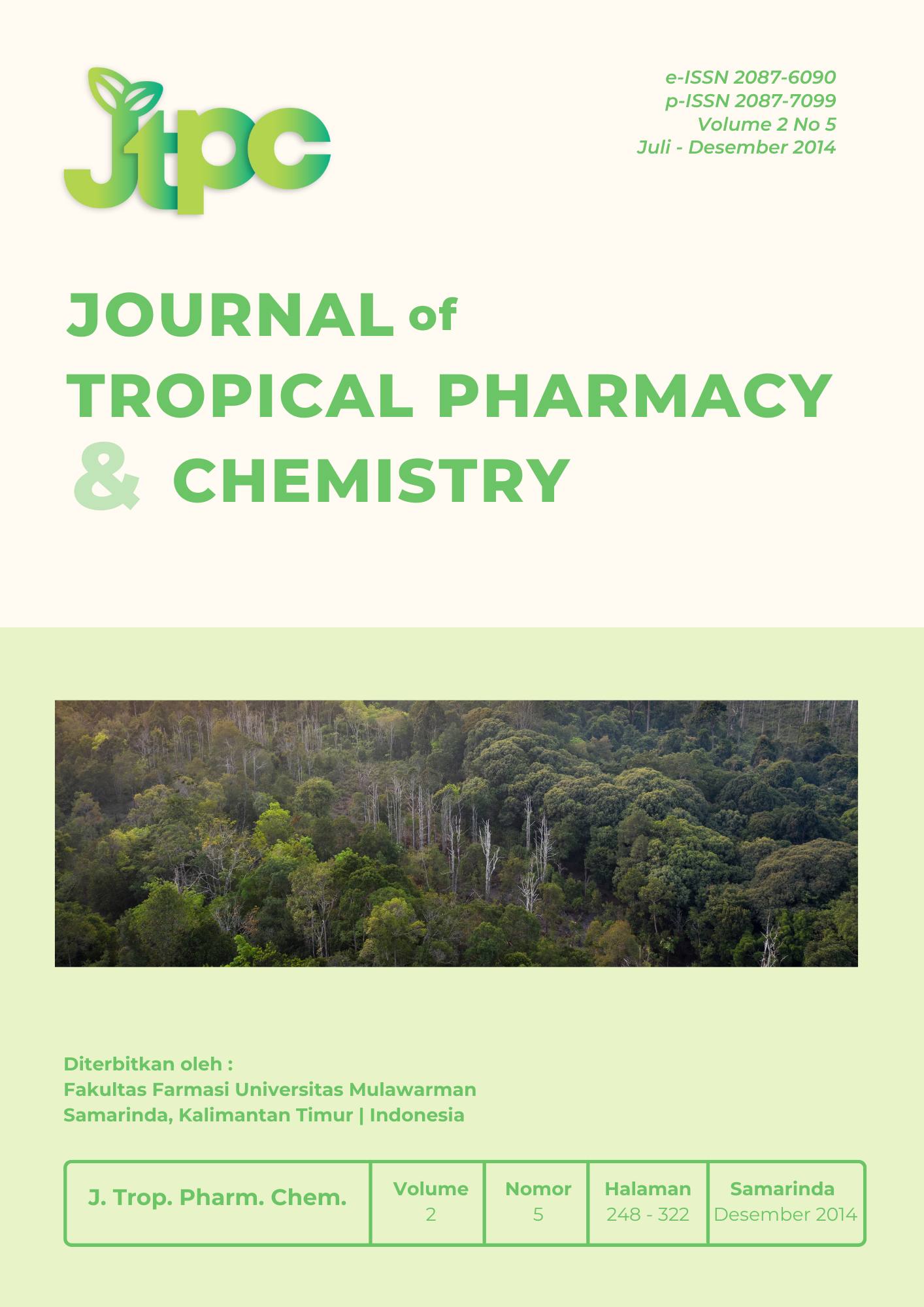Optimasi Sabun Cair Ekstrak Etanol Rimpang Zingiber officinale Rosc. var.rubrum dengan Variasi Minyak Jarak dan Kalium Hidroksida
Keywords:
Castor Oil, KOH, Simplex Lattice Design, Red GingerAbstract
One of the causes of skin diseases are bacterial infections, such as Staphylococcus aureus and Staphylococcus epidermidis. Based on previous studies of red ginger (Zingiber officinale Rosc var.rubrum) have antibacterial activity. The aimed of this research was to find the optimum concentration of castor oil and potassium hydroxide (KOH) with good physicochemical properties with Simplex Lattice Design method, and determine the effectiveness of liquid soap against Staphylococcus aureus and Staphylococcus epidermidis with disc diffusion test. Extraction of red ginger with shoxletation and 96% ethanol. The optimization liquid soap design was using Simplex Lattice Design. The basic liquid soap composition was used to predict the optimum formula contain castor oil and KOH for comparasion (0: 100), (25:75), (50:50), (75:25), (100: 0). The research showed optimum consentration value of red ginger ethanol extract is 5%. The optimum formulas contained of 40,035 g of castor oil and 10,875 g KOH. The optimum liquid soap’s colour was brown, charateristic smell of ginger, stiff, with a pH value of 9,4, viscosity of 1233 cP, 1,14% free fatty acids and alkali-free 0%. The independent T test result by using the R-2.14.1 program was p values > 0.05 against S. epidermidis and p <0.05 against S. aureus. As conclusion, the Simplex Lattice Design can produce optimum liquid soap formulas and give antibacterial effectiveness.
Downloads
References
1.Dewan Standarisasi Nasional (DSN). SNI 06-4085-1996. 1996. Sabun Mandi. Dewan Standarisasi Nasional. Jakarta. Hal. 2-5.
2.Harbone, JB. 1973 Phytochemical Methods: A guide to modern techniques of plant analysis. 3th Edition. New York: Chapman and Hall. hal 279.
3.Hawab HM. 2007. Dasar-Dasar Biokimia. Penerbit Diadit Media. Jakarta. Hal. 193; 201; 203.
4.Hernani, Bunasor T K, Fitriati. 2010.Formula Sabun Transparan Anti jamur dengan Bahan Aktif Ekstrak Lengkuas (Alpinia galangaL. Swartz.). Bul. Littro. 21(2). 192-205.
5.Indian Council of Medical Research. 2009. Detection of Antimicrobial Resistance in Common Gram Negative and Gram Positive Bacteria Encountered in Infectious deseases- An Update. ICMR Bulletin. 39(1-3).
6.Kementrian Kesehatan Republik Indonesia. 2011. Profil Kesehatan Indonesia 2010. Kementrian Kesehatan Republik Indonesia. Jakara. Hal.41-42.
7.Kristanti AN, Aminah NS, Tanjung M, Kurniadi B. 2008. Buku Ajar Fitokimia. Surabaya. University Press. Hal. 56.
8.Kurniawan D W, Sulaiman T N S. 2009. Teknologi Sediaan Farmasi. Graha Ilmu: Yogyakarta. Hal. 92-93, 97.
9.Malu S P, Obochi G O, Tawo E N, Nyong B.E. 2009. Antibacterial Activity and medicinal Properties of Ginger (Zingiber officinale). Global.
J. Pure. Appl. Sci.15(3).
10.Mishra MK, Anil K, Ashok K. 2012. Pharmacological Acivity of Zingiber officinalle. Int J Pharm Chem Scien. 1(3).
11.Notobroto, Hari B, Soedjadi K, Isa M. 2005. Faktor Sanitasi Lingkungan
Yang Berperan Terhadap Prevalensi Penyakit Scabies. Jurnal Kesehatan Lingkungan. 2(1).
12.Nursal, Wulandari S., Wilda J.S. 2006. Bioaktifitas Ekstrak Jahe (Zingiber officinaleRoxb.) dalam Menghambat Pertumbuhan Koloni Bakteri Escherichia colidan Bacillus subtilis. Laboratorium Pendidikan Biologi PMIPA FKIP Universitas Riau. Jurnal Biogenesis. 2(2). 64-66.
13.Okigbo R N, Anugasi C L, Amadi JE, Ukpabi UJ. 2009. Potential inhibitory effect of some African tuberous plant extract on Escherichia coli, Staphylococcus aureus andCandida albicans. Int J Integr Biol.
14.Radji M. 2010. Buku Ajar Mikrobilogi : Panduan Mahasiswa Farmasi dan Kedokteran. Penerbit Buku Kedokteran EGC. Jakarta. Hal. 273, 274, 280, 282, 283.
15.Robinson, T. 1983. The Organic Constituents of Higher Plants Their Chemistry and Interrelationships. 5th Ed. North Amherst: Cordus Press.
16.Rowe RC, Paul JS, Sian C.O. 2006. Handbook of Pharmaceutical
Excipients. Fifth Edition. Washington DC: Pharmaceutical Press and American Pharmacist Association. Hal. 301; 494-495; 605;
737-738.
17.Sears. 2001. Pure Radiance. Blackie Academe and Professional. London.
18.Verma P, A Ram. 2011. Effect of Different Penetration Enhancer on Skin Permeation of Drug Using Ethosom Carrier System. J Curr Pharm Res.
5(1). Hal 42-44.
19.Voigt R. 1995. Buku Pelajaran Teknologi Farmasi. Gadjah Mada University Press. Yogyakarta. Hal. 312-319.
20.Wasitaatmadja SM. 1997. Penuntun Ilmu Kosmetik Medik. Jakarta: UI Press. Hal. 98-100.
21.Watkinson C. 2000 Liquid Soap Cleaning Up Share. Inform 11. Champaign: AOCS Press. Hal. 1188-1195.




